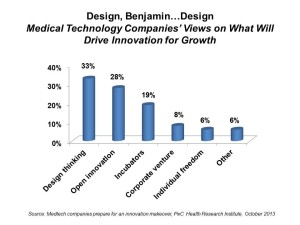Return on innovation in medical technology is on the decline. Med tech needed a GPS for its role in the health ecosystem, and lost its way as it focused on a few wrong priorities. In a $349 billion market, there has been much to lose…and will be to gain.
The new world for medical technology and how the industry can turn around is the subject of P2C’s report, Medtech companies prepare for an innovation makeover, published in October 2013 by the PwC Health Research Institute (HRI).
The problem has been an addiction to incremental improvements on existing products: think about the analog in pharma, when extending a patent by 6 months and re-casting the color of a pill or changing the dosage strength. In medtech, incrementalism is not a new-new problem. Here’s an article from a 2002 issue of Medical Device + Diagnostic Industry magazine pointing out that incremental design in medical technology would be destined to fail.
Specifically, med tech developers now admit that it’s design thinking that’s key to innovation, shown in the chart. Secondarily, open innovation can help inspire medical technology anew.
The opportunity to turn the medtech ship around is the new environment of paying for value: call it accountable, value-based, or bundled care, or paying-for-performance. That financial constraint forces medtech developers to consider health outcomes, new financing models (like sharing risk for those outcomes), convenience, supply chain efficiencies, and training.
PwC learned that:
- The value of the device isn’t just in the product itself.
- New competitors are entering, with different skills in consumer marketing, design and innovation (think: Qualcomm Life, Reebok, Samsung, and Verizon). These companies also tend to be more nimble in developing and executing strategies.
- New services and business models address joint clinician-consumer needs.
- Medtech companies innovation engines are slow – especially when it comes to adopting open innovation, analytics, mobile platforms, and cloud-based technologies.
PwC interviewed 35 medtech companies in the summer of 2013 to inform this research.
 Health Populi’s Hot Points: “Why doesn’t my glucometer look like my smartphone?” quoted a Samsung manager on behalf of a customer surveyed in PwC’s research.
Health Populi’s Hot Points: “Why doesn’t my glucometer look like my smartphone?” quoted a Samsung manager on behalf of a customer surveyed in PwC’s research.
Were we advising Benjamin Braddock of The Graduate fame, subject in the title of this post, we would argue for the primacy and centrality of design. So observe over 1 in 3 of the experts interviewed for this research. This goes hand-in-hand with open innovation: get users involved in informing design.
The cautionary tale is Hugo Campos (@HugoC), a cardiac patient I met in Silicon Valley whom I interviewed for my paper, The Connected Patient, in 2011. Hugo has an implanted cardiac defibrillator (ICD) in his chest. He’s been working diligently for several years to get access to the data that’s generated by the implanted device in his body. To date, getting access to the raw data is still a challenge.
Design encompasses a range of aspects in the eye of the user: whether an Apple-style device, a Movado-inspired aesthetic form like the Misfit Shine, or access to personal health information. So Benjamin, if you’re joining a medtech company, I’ve one word for you: Design.





 I was invited to be a Judge for the upcoming
I was invited to be a Judge for the upcoming  Thank you Team Roche for inviting me to brainstorm patients as health citizens, consumers, payers, and voters
Thank you Team Roche for inviting me to brainstorm patients as health citizens, consumers, payers, and voters  For the past 15 years,
For the past 15 years,